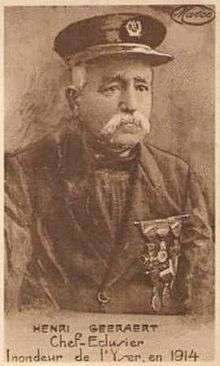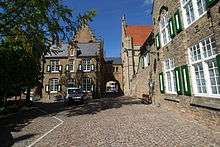Hendrik Geeraert



Hendrik Geeraert (15 July 1863, Nieuwpoort, Belgium – 17 January 1925, Bruges) was a Belgian folk hero during the interwar period who he came to symbolize the Belgian resistance movement against the German forces during World War I. He became famous among the Belgian soldiers in 1914 at the Battle of the Yser. Serving as a Nieuwpoort skipper, he opened the sluices (a Dutch water channel controlled by a gate) of the Yser River, flooding the polders and bringing the advancing German army to a halt.
Geeraert was born at Langestraat 40 in Nieuwpoort, the son of skipper Augustine Gheeraert and Anna Veranneman, a housekeeper, and lace-maker. Hendrik also became a skipper. At the age of 24, he married Melanie Jonckheerein in Veurne. The couple had eight children.
Water Inundation
In October 1914, Geeraert was put in touch with the Belgian engineering detachment of sapper sailors that guarded the sluices in Nieuwpoort. On 21 October they were ordered by the High Command to protect the endangered bridgehead at Lombardsijde by flooding the polder at Nieuwendamme. Geeraert successfully aided the operation.
This was, however, a temporary respite and on 25 October they decided to flood the entire region between Nieuwpoort and Diksmuide. Karel Cogge, a Veurne local who worked for the water board, put forward two plans the first of which being rejected after being vetoed by the High Command. The first attempt, which followed Cogge's Plan B did not yield the expected results.
On 29 October, the High Command decided to go ahead and carry out Cogge's Plan A, which involved the opening of the spillway at the Ganzepoot sluice and lock complex in Nieuwpoort. Geeraert assisted in this effort. After the gates were raised, the area was slowly flooded, creating a marshland that spread as far as Diksmuide, avoiding a full German occupation of Belgium.[1] After this success, the 51-year-old Geeraert remained with the company that operated the Ganzepoot for the remainder of the war.
At the end of the war, he became mortally ill. On his deathbed 25 December 1924, he was awarded the Order of Leopold. He was also called a "Legendary figure of the field Army during World War I", an unofficial title which was also used for King Albert I of Belgium. He also received service medals with seven bars for his service at the front. He died in the St. Julius Almshouse of the Brothers of Charity in Bouveriestraat in Bruges on 17 January 1925.[lower-alpha 1] He was buried with honors.
In the 1950s, his portrait was printed on the 1000 Belgian franc banknote.
See also
- Floodgate
- Gatehouse (waterworks) – An (elaborate) structure to house a sluice gate
- Hydraulic engineering
- Lock
- West Flanders
References
- ↑ St. Julius disappeared in 1931. The medieval charitable institution has existed since 1275 and devoted itself, from 1600 onward, to the care of "dulle people" or the insane and foundlings. The Brothers of Charity formed together with its almshouses and the neighboring Blind Club's misery corner.
Works
- Begrafenis van H. Geeraert. In: Westvlaamse Gidsenkring Westhoek, 40 (2004), 3, p. 24-26.
- Bert Bijnens, Wat herinnert in Nieuwpoort nog aan Hendrik Geeraert (1863-1925) - De held van de overstroming. In: Bachten de Kupe, 41 (1999), 4, p. 171-187.
- Godgaf Dalle, Nieuwpoort 14-18. In: De Gidsenkring, 4 (1966), 2, p. 7-9.
- P. Darge, Voor memorie. In: Westvlaamse Gidsenkring Westhoek, 22 (1985), 3, p. 2-13.
- L. De Wolf, Karel Cogge's medewerking aan de onderwateringe in 14. In: Biekorf, 30 (1924), 5 p. 112-113.
- L. De Wolf, Veurne-Ambacht en de onderwateringe in 1914. In: Biekorf, 30 (1924), 2, p. 40-43.
- Karel Lodewijk Cogge. In: Curiosa, 33 (1995), 325, P. 27-28.
- Marcel Messiaen, Hendrik Geeraert, held van de IJzer 50 jaar geleden. In: Bachten de Kupe, 7 (1985), 7, p. 127-138.
- M. Nevejans, De waarheid over K. Cogge. In: Bachten de Kupe, 19 (1977), 6, p. 89-93.
- Luc Vanacker, De IJzer oktober 1914. Een slag te veel? Het idee en de timing van de eerste onderwaterzetting. In: Westvlaamse Gidsenkring Westhoek, 39 (2003), 3, p. 1-21 & in: Shrapnel, 16 (2004), 1, p. 26-48.
- Patrick Vanleene & Jacques Bauwens, Over Karel Cogge. In: Westvlaamse Gidsenkring Westhoek, 40 (2004), 3, p. 1-23.
- Paul Van Pul, Oktober 1914. De initiële inundaties aan het Belgische front. In: Belgisch Tijdschrift voor Militaire Geschiedenis, 30 (1994), 7, p. 541-561.
- H.J. Vanthuyne, De rol van het Vleterse bij de onderwaterzetting in 1914-1918. In: Vlietmara, 4, (1982), 1, p. 13-17.
- M. Van Wesemael, Nog enig nieuws over de IJzer-inundatie van 1914. In: Bachten de Kupe, 25 (1983), 3, p. 69-73.
- Roger Verbeke, De overstroming van de IJzerstreek gedurende Wereldoorlog I. In: De Gidsenkring, 19 (1981), 1, p. 13-16.
External links
- (Dutch) 1000 franc note before the Battle of the Yser
- (Dutch) Geeraert on Milpedia
| Wikimedia Commons has media related to Hendrik Geeraert. |